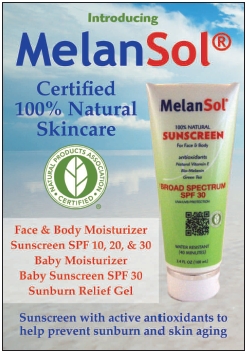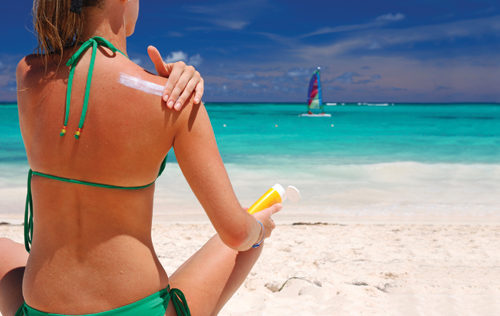Skin cancer is a scary possible consequence of spending too much time in the sun, with the scariest and most severe form being melanoma. Melanoma is caused by changes in melanocyte cells that are responsible for producing melanin (skin and hair color), and may appear as a mole, although a previously benign mole can develop into melanoma (1). Melanomas are said to be developed through too much sun exposure, sometimes even developing later in life due to too many bad sunburns as a child.
Reducing sunlight exposure, especially between 10 a.m. and 4 p.m. when ultraviolet (UV) light is at its peak, is a good preventative technique, but what about your customers who want to spend time in the sun? Sunscreen is the answer. With the rate of melanoma, a once uncommon form of skin cancer, dangerously rising, it’s time to teach your customers about their options when it comes to protecting their skin while having fun in the sun.
The Necessary Evils
Natural sunscreen is an alternative to mainstream sun protectants without the excess and unnecessary chemicals. They incorporate ingredients like grape seed oil and green tea leaf extract instead. Natural sunscreens often use two minerals to bring users full-spectrum protection against UV rays.
Titanium dioxide and zinc oxide, often micronized into powder, reflect harmful rays. Zinc oxide is an FDA-approved sunscreen ingredient that works by scattering and absorbing radiation UVA, UVB and UVC while protecting the skin underneath. When combined with titanium oxide, the pair provides full spectrum protection to the user (2).
Micronized titanium dioxide and zinc oxide may be so small they are considered nanoparticles; this is where the controversy begins. Nanoparticles are tiny compounds measured in nanometers (1 to 100 billionths of a meter), and lead some people to believe that due to their incredibly small size, nanoparticles can be absorbed and do harm to the body from within (2). There are conflicting data on this subject; most studies with nanoparticles of titanium dioxide and zinc oxide show that they do not penetrate healthy, intact skin (3). The danger lies in inhaling nanoparticles; sunscreens with propellants or that come in loose, powdered form run the risk of being inhaled by the user and coating their lungs with potentially harmful particles (3). Some feel this causes interference with cellular signaling, cell mutation and cell death within the lungs (3). Other researchers are concerned with carcinogenicity and the environmental impact of the particles, but evidence and studies are still limited on this research.
Saying No to Nano
To sidestep the possibility of absorption, some companies are taking a “Non-Nano” stance, and not including nanoparticles in their sun protection products, opting instead for larger uncoated, non-nano zinc oxide. One company claims that particles of zinc oxide larger than 30 nanometers are considered much safer than their nanoparticle counterparts since their size will stop the possibility of absorption into the skin and bloodstream, eliminating any potential harm (2).
The downside to using a non-nano product is that some research suggests smaller particles work better (4), although the makers of branded non-nano sunscreens say otherwise. Another downside is purely aesthetic: to make a sunscreen using zinc oxide and titanium dioxide at least an SPF 30, about 20% of the formula needs to be made of the oxide, causing the substance to be harder to rub in and leaves behind whitening on the skin (2). Using products with nanoparticles will make the whitening a non-issue. Depending on how your customers feel, some won’t mind the whitening for the possibility of added protection, while others will field the possible risks of nanoparticles to avoid looking like a snowman on the beach.
The Unnecessary Evil
Either way, these options are better than some of the alternatives. Oxybenzone is found in the majority of mass-marketed sunscreens because of its superior abilities as a UV light absorber and filter. However, unlike with nanoparticles, it is conclusive that oxybenzone is absorbed into the skin, with 97% of Americans currently contaminated with the chemical, according to the Center for Disease Control (CDC) (5). It has also been shown as an allergen and is banned in some Japanese cosmetics (5). Other unwanted ingredients to tell your customers to avoid in their sunscreens are octinoxate (similar to oxybenzone) and vitamin A (as retinyl palmitate), which can make the skin more sensitive to sunlight (6).
It is also important to protect the skin from insects to avoid the possibility of a carried disease or just an itchy annoyance, while spending time in the sun. Some people, however, don’t know where to turn for a natural shield. Avoiding diethyltoluamide, or DEET, a pesticide also used in insect repellents, is important to some concerned about the possible negative health effects; according to the CDC, cases of mild skin irritation, psychological problems and even death (although rare and caused by ingesting large quantities of DEET) have been reported, and suggest that DEET be applied to clothing as opposed to the skin.
As an alternative, the CDC recommends oil of lemon eucalyptus in place of chemical repellents, while branded natural repellents often incorporate other oils such as cedar, geranium, and cinnamon. For increased outdoor protection, some sunscreens combine sun and insect protection with ingredients like eucalyptus, citronella and clove so that nothing gets in the way of a fun, outdoor adventure.
Most sunscreen companies suggest reapplying every one to two hours, especially after toweling off from a swim. For best sun protection, advise your customers to wear protective clothing and take advantage of the shade, especially children. If your customers are concerned with losing out on vitamin D while wearing sunscreen, most sunscreen companies say that it may be a little inhibited, but vitamin D can still be absorbed while protecting skin with sunscreen. Let your customers know about vitamin D supplement alternatives if they are not convinced. WF
References
1. “Melanoma,” www.ncbi.nlm.nih.gov/pubmedhealth/PMH0001853, accessed May 21, 2012.
2. “Zinc Oxide & Nanoparticles in Sunscreen,” www.badgerbalm.com/s-33-zinc-oxide-and-nanoparticles.aspx, accessed May 21, 2012.
3. “Zinc Oxide (sunscreen grade >100mg),” www.ewg.org/skindeep/ingredient/703959/ZINC_OXIDE_%28sunscreen_grade_%3E_100nm%29/#, accessed May 21, 2012.
4. “Titanium Dioxide (sunscreen grade),” www.ewg.org/skindeep/ingredient/726566/TITANIUM_DIOXIDE_%28sunscreen_grade%29/#, accessed May 21, 2012.
5. “Oxybenzone,” www.ewg.org/skindeep/ingredient/704372/OXYBENZONE/#, accessed May 21, 2012.
6. “Nutrients for Healthy Skin,” http://www.webmd.com/healthy-beauty/features/skin-nutrition, accessed May 23, 2012.
Published in WholeFoods Magazine, July 2012









